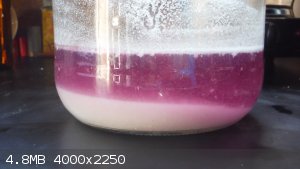
C7H5N3O6 - 28-12-2016 at 23:20
I cannot find out what reaction occurred during this, any help would be nice.
I had an old gallon pickle jar that I used for electrolysis of KCl that had a little bit of liquid in it and it froze one night. I let it turn back
to liquid and there was some precipitate that was stuck to the bottom. I'm guessing it was a little potassium hydroxide, potassium chloride, and
potassium chlorate. I diluted this with some water and left it until today.
Today I dumped some ASA (acetylsalicylic acid) partially dissolved in acetone into the jar. I looked at it about an hour later and it formed a creamy
looking layer and a more clear layer. This morning, I looked at it and it had changed colors to a pink/purple color! There is still two layers, a
white creamy layer and the larger pink/purple layer!
I attached a photo of what it looked like the next day.
Any idea what happened? I'm an absolute beginner so I have no idea, thanks.

[Edited on 29-12-2016 by C7H5N3O6]
[Edited on 29-12-2016 by C7H5N3O6]
phlogiston - 29-12-2016 at 02:30
Pretty color.
If you honestly care to find out, start by making well-defined mixtures of the chemicals you think are in there so you can consistently reproduce it.
As most organic chemicals and the ions you mention tend to be colorless/white, don't overlook the possible presence of metal ions in the residual
liquid that was in the jar (for instance from the electrodes you used).
brubei - 29-12-2016 at 02:46
Salicylic oxydation by chlorate probably result in auto condensation, maybe including aceton carbonyl but not for sure.
https://www.ncbi.nlm.nih.gov/pubmed/20979409
[Edited on 29-12-2016 by brubei]
unionised - 29-12-2016 at 04:49
Looks the right colour for the iron(III) salicylate complex.
C7H5N3O6 - 30-12-2016 at 22:10
Thanks everyone, I'm going to attempt to reproduce it.
